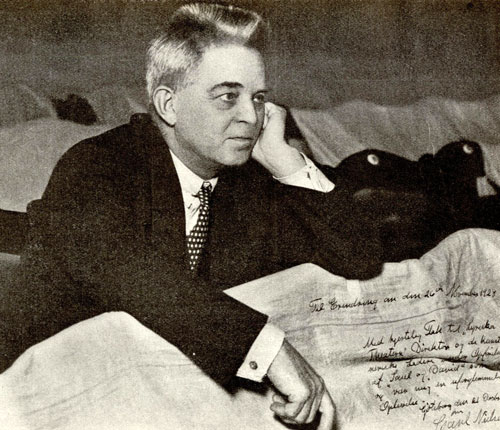Van de Wiel, Philharmonia, Järvi, RFH | reviews, news & interviews
Van de Wiel, Philharmonia, Järvi, RFH
Van de Wiel, Philharmonia, Järvi, RFH
Performances of Nielsen and Haydn that needed more orchestral focus

“Choleric humour, pathos and kindliness are mingled in conflict," wrote Robert Simpson of Nielsen’s 1928 Clarinet Concerto. The work was written for a player with a complex character, full of contradictions. Last night’s soloist, Mark van de Wiel, the Philharmonia's principal clarinettist, gave a fluent performance of the work convincing on its own terms, portraying the protagonist as an introvert and anti-hero.
There are performances which bring to the fore much more of the humour, the tendency to cajole and tease that are there in this work. This one was firmly fixed on its darker side. Particularly successful were the irascible episodes where the soloist is spurred to gruffness and anger by the provocations of a side drum – played by the excellent and characterful Matt Prendergast, one of no fewer than 10 guest principals on stage last night.
 Paavo Järvi (main picture) also brought out the accented folk dance rhythms well, causing the soloist at one point to a visible physical reaction - an almost involuntary shimmy, a rare moment of cheerfulness. The ending, where the soloist finally finds calm, was convincing from him, and yet a disappointment overall. The upper strings somehow failed to give van de Wiel (pictured right) enough of the tendernesss and solace that is clearly there in the string writing; their phrases were lacking in both pathos and definition.
Paavo Järvi (main picture) also brought out the accented folk dance rhythms well, causing the soloist at one point to a visible physical reaction - an almost involuntary shimmy, a rare moment of cheerfulness. The ending, where the soloist finally finds calm, was convincing from him, and yet a disappointment overall. The upper strings somehow failed to give van de Wiel (pictured right) enough of the tendernesss and solace that is clearly there in the string writing; their phrases were lacking in both pathos and definition.
The absence of convincing shape to the string phrasing was also a feature which compromised the opening work, Haydn’s Symphony No. 83 in G minor. There were lightness, humour and efficiency in the outer movements, but the Andante lacked both lyricism and depth.
 The work in the second half was Nielsen’s Third Symphony of 1910-11, the Espansiva. This performance brought to mind the pull-out quote which Paavo Järvi’s management have put very prominently on his page on their website, as his calling card: “Järvi clearly prizes highly charged music making, often at top speed, with thoughtful phrasing and sharply punched accents… these qualities yield refreshing, powerful performances.” Järvi has gestures – the underarm sweep, the forward lunge, the stamping foot - which whip up the orchestra to a blazing tutti.
The work in the second half was Nielsen’s Third Symphony of 1910-11, the Espansiva. This performance brought to mind the pull-out quote which Paavo Järvi’s management have put very prominently on his page on their website, as his calling card: “Järvi clearly prizes highly charged music making, often at top speed, with thoughtful phrasing and sharply punched accents… these qualities yield refreshing, powerful performances.” Järvi has gestures – the underarm sweep, the forward lunge, the stamping foot - which whip up the orchestra to a blazing tutti.
When all 13 brass players were going for it, the sound was glorious. There were sections, such as the eight-strong bass contingent, which responded with unanimity and presence. Todd Gibson-Cornish as principal bassoon was highly effective throughout. But there were moments when expectations were unfulfilled, such as when Järvi was cajoling the horns which Nielsen (pictured above left in the year of the Clarinet Concerto, 1928) often uses to herald the transition to a new temperament. This performance ran the risk of becoming just a series of highlights: when the intensity was pulled back, the orchestra's focus and purpose became less distinct.
rating
Share this article
The future of Arts Journalism
You can stop theartsdesk.com closing!
We urgently need financing to survive. Our fundraising drive has thus far raised £49,000 but we need to reach £100,000 or we will be forced to close. Please contribute here: https://gofund.me/c3f6033d
And if you can forward this information to anyone who might assist, we’d be grateful.

Subscribe to theartsdesk.com
Thank you for continuing to read our work on theartsdesk.com. For unlimited access to every article in its entirety, including our archive of more than 15,000 pieces, we're asking for £5 per month or £40 per year. We feel it's a very good deal, and hope you do too.
To take a subscription now simply click here.
And if you're looking for that extra gift for a friend or family member, why not treat them to a theartsdesk.com gift subscription?
more Classical music
 Jakub Hrůša and Friends in Concert, Royal Opera review - fleshcreep in two uneven halves
Bartók kept short, and a sprawling Dvořák choral ballad done as well as it could be
Jakub Hrůša and Friends in Concert, Royal Opera review - fleshcreep in two uneven halves
Bartók kept short, and a sprawling Dvořák choral ballad done as well as it could be
 Monteverdi Choir, ORR, Heras-Casado, St Martin-in-the-Fields review - flames of joy and sorrow
First-rate soloists, choir and orchestra unite in a blazing Mozart Requiem
Monteverdi Choir, ORR, Heras-Casado, St Martin-in-the-Fields review - flames of joy and sorrow
First-rate soloists, choir and orchestra unite in a blazing Mozart Requiem
 Cho, LSO, Pappano, Barbican review - finely-focused stormy weather
Chameleonic Seong-Jin Cho is a match for the fine-tuning of the LSO’s Chief Conductor
Cho, LSO, Pappano, Barbican review - finely-focused stormy weather
Chameleonic Seong-Jin Cho is a match for the fine-tuning of the LSO’s Chief Conductor
 Classical CDs: Shrouds, silhouettes and superstition
Cello concertos, choral collections and a stunning tribute to a contemporary giant
Classical CDs: Shrouds, silhouettes and superstition
Cello concertos, choral collections and a stunning tribute to a contemporary giant
 Appl, Levickis, Wigmore Hall review - fun to the fore in cabaret and show songs
A relaxed evening of light-hearted fare, with the accordion offering unusual colours
Appl, Levickis, Wigmore Hall review - fun to the fore in cabaret and show songs
A relaxed evening of light-hearted fare, with the accordion offering unusual colours
 Lammermuir Festival 2025, Part 2 review - from the soaringly sublime to the zoologically ridiculous
Bigger than ever, and the quality remains astonishingly high
Lammermuir Festival 2025, Part 2 review - from the soaringly sublime to the zoologically ridiculous
Bigger than ever, and the quality remains astonishingly high
 BBC Proms: Ehnes, Sinfonia of London, Wilson review - aspects of love
Sensuous Ravel, and bittersweet Bernstein, on an amorous evening
BBC Proms: Ehnes, Sinfonia of London, Wilson review - aspects of love
Sensuous Ravel, and bittersweet Bernstein, on an amorous evening
 Presteigne Festival 2025 review - new music is centre stage in the Welsh Marches
Music by 30 living composers, with Eleanor Alberga topping the bill
Presteigne Festival 2025 review - new music is centre stage in the Welsh Marches
Music by 30 living composers, with Eleanor Alberga topping the bill
 Lammermuir Festival 2025 review - music with soul from the heart of East Lothian
Baroque splendour, and chamber-ensemble drama, amid history-haunted lands
Lammermuir Festival 2025 review - music with soul from the heart of East Lothian
Baroque splendour, and chamber-ensemble drama, amid history-haunted lands
 BBC Proms: Steinbacher, RPO, Petrenko / Sternath, BBCSO, Oramo review - double-bill mixed bag
Young pianist shines in Grieg but Bliss’s portentous cantata disappoints
BBC Proms: Steinbacher, RPO, Petrenko / Sternath, BBCSO, Oramo review - double-bill mixed bag
Young pianist shines in Grieg but Bliss’s portentous cantata disappoints
 theartsdesk at the Lahti Sibelius Festival - early epics by the Finnish master in context
Finnish heroes meet their Austro-German counterparts in breathtaking interpretations
theartsdesk at the Lahti Sibelius Festival - early epics by the Finnish master in context
Finnish heroes meet their Austro-German counterparts in breathtaking interpretations
 Classical CDs: Sleigh rides, pancakes and cigars
Two big boxes, plus new music for brass and a pair of clarinet concertos
Classical CDs: Sleigh rides, pancakes and cigars
Two big boxes, plus new music for brass and a pair of clarinet concertos

Add comment